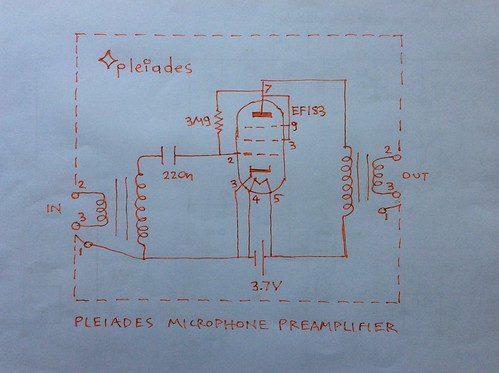This is the very low plate potential to electron tubes experiments continued. This time with an AA 1.2V battery supplying plate or anode at a fixed low potemtial.
For safety always use a fuse in series with a battery, power supply.
On this experiment the Pleiades bread board expernetal jig is used configured to Pleiades V6.

The electron tube used is the Nuvistor 7586. Cc is 22nF. The mic input transformer is the Altec 4722. A pull up resistor of 6MΩ or one of less than 1.8MΩ is used for Pleiades bias. Heater is connected to 3 AA batteries. A forth battery is used for 1.2V plate supply. The output transformer is a 10:1 with such inductance as to start low cut below approx 120Hz (more information of the Pleiades 10:1 output transformer on previous posts).
The experiment is done to get insight on how would a Nuvistor 2DV4 operate with just one 1.2V battery powering both heater and plate or anode.
Signal path, setup:
Male singing voice from 12in to 1in - Sennheiser MD441 U3 or MD211 - Pleiades V6 as described above - Sony TC-D5 Pro - Sennheiser HD580
Firstly the anode was powered by 3.9V.
The sound was bass heavy on MD441 U3 as expected due to proximity effect, Fletcher Munson, voice effort curves. The mic could be used at >12in.
A Pleiades 130Ω,40mH gentle slope low cut hiss pass filter was inserted between mic and headamp. The sound was much clearer, bright not bass heavy. Not perhaps the best sound as it needs fine tuning (see Freed military transformer with variable inductance with respect to frequency).The mic could be used at 1-2in.
Then 1.2V was connected to the plate. The anode current dramatically decreased but the amplifier still operated. Bass response and some gain was reduced. Bass reduction is expected from increase of internal anode resistance driving the primary inductance of the output transformer.
This bass reduction made possible the use of the MD441 at 1in. A nice sound.
Changing the pull up bias resistor from 6MΩ to 6MΩ//1.8MΩ increased the plate current but still to a low value of 4-5μA?. The amplifier operated with somewhat more bass so the MD441 could be used at approx 3in.
At this setting the MD211 sounded very nice, loud at 2in.
Next a male XLR with a 0Ω link was connected to investigate a bit noise behaviour. The noise hiss went down as expected. Then a link was connected between Cc and ground and noise went further down.
This shows that the head amp can discriminate between 0Ω and the thermal noise introduced by the input transformer. A 200Ω wire wound resitor male XLR link (resistor connected to pins 2.3) was also connected and the headamp could hear the 200Ω thermal noise.
The subjective behaviour on noise was perhaps not as great as the Pleiades V6 with 3.9V for both heaters and plate but it was very good anyway. More investigation experiments are needed.
The experiment was stopped by the Sony TC-D5 Pro rechargeable AA batteries going down.
Next day addition. What is the grid bias of the 7586 at such 1.2V plate supply, Pleiades bias conditions?
Before connecting heater voltage the grid bias is as expected 1.2V. As soon as 3.9V heater voltage is applied and cathode temperature start to increase the grid bias gradually drops to -88mV. It would have been typically -700mV without the Pleiades pull up resistor. And of course an even more negative bias should the electron tube heater was connected to 6.3V.
So using a 1.8MΩ pull up resistor the grid bias was measured -88mV and 100mV when a 10Ω resistor was connected in series with heaters. This amplifier operates this way too. When a 6MΩ pull up Pleiades bias resistor was used the grid bias was measured -140mV and 15mV when a 10Ω resistor was in series with the heater supply of 3.9V. (A fuse should always be used in series with any voltage supply for safety).
See also tomorrow's post on further increasing pull up bias which made the sound worse and decreased dramatically gain.
http://euroelectron.blogspot.com/2018/07/too-much-electron-tube-pull-up-or.html
No comments:
Post a Comment